Explore Ontario’s hidden historical gems through immersive heritage projects that bring our past to life. Step into a 19th-century log cabin restoration project at Algonquin Provincial Park, where skilled craftspeople demonstrate traditional building techniques every summer weekend. Join Indigenous knowledge keepers for guided medicine walks through Pinery Provincial Park, learning about sacred plants and time-honored harvesting practices passed down through generations. Participate in archaeological digs at Murphys Point, where visitors uncover artifacts from early settler homesteads while professional archaeologists share stories of pioneer life.
These hands-on experiences connect modern adventurers with Ontario’s rich cultural tapestry, offering unique opportunities to preserve and celebrate our shared heritage. Whether you’re documenting oral histories from local elders, helping restore historic trails, or participating in traditional craft workshops, these heritage projects provide meaningful ways to safeguard our province’s diverse cultural legacy for future generations.
First Nations Heritage Trails and Stories
The Petroglyphs Provincial Park Experience
At Petroglyphs Provincial Park, visitors can immerse themselves in one of Ontario’s most significant Indigenous heritage sites through the renowned Teaching Rocks program. This sacred space features over 900 petroglyphs carved into crystalline limestone, representing the largest known concentration of Indigenous rock carvings in Canada.
The park’s interpretive programs are thoughtfully delivered in partnership with local Indigenous communities, offering visitors authentic insights into Anishinaabe culture and traditions. During guided experiences, knowledgeable staff share the stories behind these mysterious carvings, which include images of humans, animals, and spiritual beings that date back hundreds of years.
For the most enriching experience, visit during morning hours when the angled sunlight makes the petroglyphs more visible. The Learning Place Visitor Centre provides context through interactive displays and multimedia presentations that help bring these ancient teachings to life. Kids particularly enjoy the hands-on activities where they can create their own petroglyph-inspired artwork.
Pro tip: Join one of the scheduled medicine walk programs, where Indigenous guides share knowledge about traditional healing plants found along the park’s trails. Remember to approach the site with respect, as it remains a sacred place for Indigenous peoples. Photography isn’t permitted at the main petroglyph site, but you can purchase educational materials from the visitor center to remember your experience.
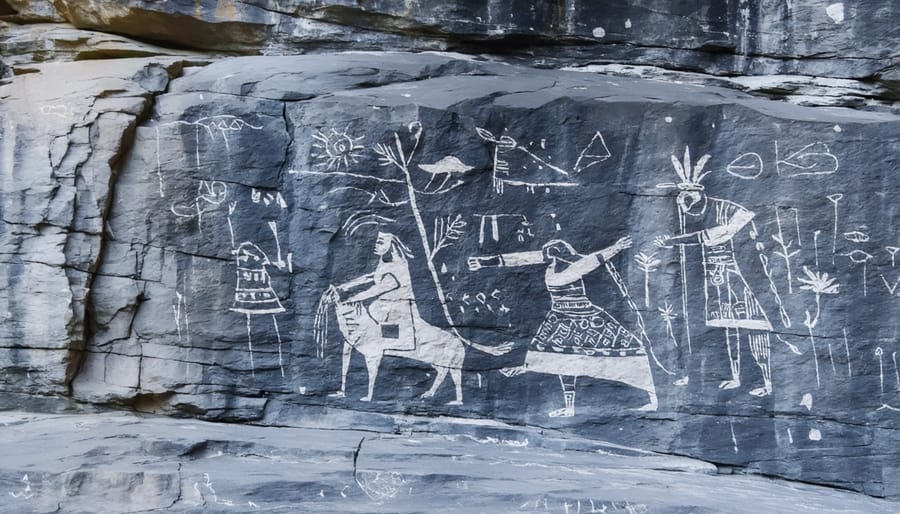
Point Pelee’s First Nations Heritage Walk
Step into the rich cultural tapestry of Point Pelee National Park through its immersive First Nations Heritage Walk program. Led by Indigenous knowledge keepers, these guided walks along scenic heritage trails offer visitors a unique opportunity to connect with the land’s ancestral stewards and their enduring traditions.
During the two-hour experience, participants learn about medicinal plants, traditional hunting practices, and the deep spiritual connection between Indigenous peoples and the park’s diverse ecosystems. The walks feature interactive demonstrations of traditional crafts, including basket weaving using local marsh grasses and the art of making dreamcatchers.
A highlight of the program is the sacred smudging ceremony, where visitors can participate in this cleansing ritual using traditional medicines like sage and sweetgrass. Storytelling sessions around the gathering circle bring ancient legends to life, helping visitors understand the cultural significance of Point Pelee’s landscapes.
Pro tip: These walks are offered from May through October, with special dawn ceremonies during the summer solstice. Book at least two weeks in advance, as groups are kept intimate (maximum 15 people) to ensure an authentic experience. Remember to wear comfortable walking shoes and bring a reusable water bottle to minimize environmental impact.
Pioneer Life Recreation Projects
Murphys Point’s McParlan House
Step back in time at McParlan House, a beautifully restored 1800s homestead nestled within Murphys Point Provincial Park. This living history site offers visitors a unique opportunity to explore Ontario’s wild heritage through immersive experiences and hands-on demonstrations.
Originally built by the McParlan family in the 1850s, the restored log house now serves as a window into pioneer life in Upper Canada. From Victoria Day weekend through Labour Day, costumed interpreters bring history to life, demonstrating traditional skills like bread baking in the outdoor oven, butter churning, and wool spinning.
Kids particularly love the interactive elements, where they can try their hand at period games, help tend the heritage garden, or assist with daily chores using authentic tools from the era. The site’s popular “Pioneer Life” programs run every Wednesday and Sunday afternoon during summer months, featuring special demonstrations of blacksmithing, quilting, and other traditional crafts.
Don’t miss the annual Heritage Mica Days festival in August, when the McParlan House becomes a hub of activity celebrating the area’s mining history. Insider tip: Plan your visit for Wednesday afternoons when fresh-baked treats often emerge from the outdoor oven – there’s nothing quite like sampling heritage recipes in their original setting!
The house is wheelchair accessible, and guided tours are available upon request. Remember to bring your camera to capture the picturesque setting and your family trying their hand at pioneer activities.
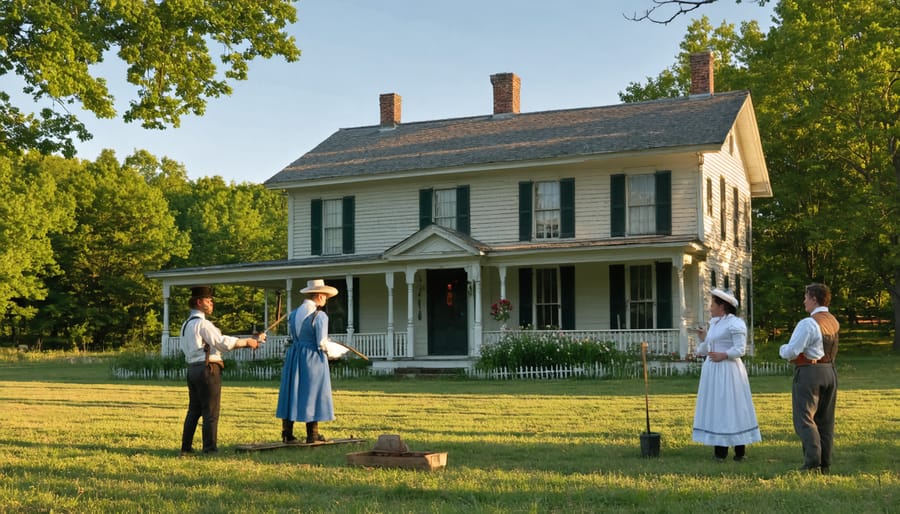
Forks of the Credit Mill Ruins
Nestled within the picturesque Forks of the Credit Provincial Park, the historic mill ruins stand as a testament to Ontario’s rich industrial heritage. This fascinating interpretation program brings to life the story of the Credit Valley Railway and the bustling mill operations that once dominated the landscape in the late 1800s.
Visitors can explore the carefully preserved stone foundations and learn about the water-powered mills that processed everything from lumber to grain. Interactive panels along the self-guided trail explain how the mill’s massive wooden water wheel harnessed the power of the Credit River, while historic photographs help visitors imagine the site in its heyday.
The program includes seasonal guided tours where knowledgeable interpreters share stories about the mill workers’ daily lives and the crucial role these operations played in developing the region. Kids particularly enjoy the hands-on demonstrations of traditional milling techniques during special event weekends.
Pro tip: Visit during spring or fall when the water levels are optimal and the surrounding maple forest puts on a spectacular show of colors. The short hiking trail to the ruins is moderately challenging but rewards visitors with stunning views of the river valley. Remember to bring your camera – the contrast between the weathered stone ruins and the natural landscape makes for remarkable photos.
The site also features accessible viewing platforms and rest areas, making this heritage experience available to visitors of all mobility levels. For the best experience, plan to spend about an hour exploring the ruins and surrounding area.
Maritime Heritage Programs
Fathom Five’s Shipwreck Tours
Beneath the crystal-clear waters of Georgian Bay lies a captivating underwater museum of perfectly preserved shipwrecks, each telling a unique story of Great Lakes maritime history. Fathom Five’s guided shipwreck tours offer visitors a chance to explore these remarkable time capsules through various exciting programs.
For certified divers, the park provides guided diving experiences to sites like the Sweepstakes, a 19th-century wooden schooner resting in shallow waters near Tobermory’s harbor. The vessel’s intact hull and deck features create an otherworldly scene that attracts underwater photographers from around the globe.
Don’t worry if you’re not scuba-certified – the park’s glass-bottom boat tours make these underwater treasures accessible to everyone. The specially designed vessels cruise over multiple shipwreck sites while naturalist guides share fascinating tales of storms, heroic rescues, and life aboard Great Lakes ships.
For a truly unique perspective, join the park’s snorkeling program during summer months. Under expert guidance, you’ll float above the shallow-water wrecks, getting an up-close view of these historic vessels while learning about their significance to Ontario’s maritime heritage.
Insider tip: Book your tour for early morning when the water is usually calmest and visibility is at its best. Don’t forget to bring an underwater camera – the clear waters make for stunning photos of these silent sentinels of the past.

Presqu’ile’s Lighthouse Experience
Standing sentinel on the shores of Lake Ontario, Presqu’ile’s historic lighthouse has been faithfully guiding mariners since 1840. Today, this beautifully preserved structure serves as both a working navigational aid and a fascinating window into Ontario’s maritime heritage. Through a collaborative effort between Ontario Parks and local community groups, the lighthouse has been carefully restored to showcase its original 19th-century architecture while incorporating modern interpretive elements.
Visitors can join guided tours during summer months, where knowledgeable interpreters share captivating stories of lighthouse keepers and their families who once called this tower home. The interactive exhibits inside feature authentic artifacts and compelling photographs that bring the lighthouse’s rich history to life. Kids especially love the hands-on activities, including signal flag demonstrations and the chance to operate a replica fog horn.
Insider tip: Plan your visit for sunset when the lighthouse is particularly photogenic, and you might catch the automated light system in action. For the best experience, time your visit with one of the special evening programs where you can climb to the top of the tower for panoramic views of the bay.
The preservation project also includes accessible pathways and eco-friendly solar lighting, ensuring this heritage gem can be enjoyed by everyone while minimizing environmental impact. Don’t miss the newly installed interpretive panels along the lighthouse trail, which highlight the vital role these beacons played in Great Lakes maritime history.
Interactive Heritage Activities
Archaeological Digs at Bonnechere
Ever dreamed of being an archaeologist? The Bonnechere Public Archaeology Program lets you live that dream! Each summer, visitors can join real archaeological digs at the historic Bonnechere River Valley, uncovering artifacts from the region’s logging and farming past.
Under the guidance of professional archaeologists, participants get hands-on experience using archaeological tools, learning proper excavation techniques, and documenting their finds. The program welcomes both beginners and experienced diggers, making it perfect for families and history enthusiasts alike.
During the dig, you might uncover anything from old pottery and tools to personal items left behind by early settlers. Each discovery helps piece together the story of the people who lived and worked along the Bonnechere River generations ago.
The best part? You’re contributing to real research while learning about Ontario’s heritage. The program runs weekly sessions throughout July and August, with morning and afternoon options available. Remember to wear comfortable clothes, bring sun protection, and prepare to get your hands dirty – in the most fascinating way possible!
Tip: Book your spot early, as these popular sessions fill up quickly. It’s an unforgettable way to connect with Ontario’s past while creating your own memories.
Historic Skills Workshops
Step back in time and learn authentic heritage skills from master craftspeople who keep Ontario’s traditional practices alive. These hands-on workshops offer unique opportunities to experience historical techniques firsthand, from blacksmithing to traditional woodworking.
Popular programs include the Pioneer Craft Series at Upper Canada Village, where participants learn traditional rope making, candle dipping, and textile weaving. At Fort William Historical Park, you can master the art of birch bark canoe building or try your hand at traditional beadwork under the guidance of Indigenous artisans.
Photography enthusiasts can join specialized workshops to capture historical sites and artifacts using both modern and period-appropriate techniques. These sessions often include tips for documenting heritage buildings and creating compelling visual stories of Ontario’s past.
For those interested in culinary heritage, seasonal workshops demonstrate historical cooking methods, from bread baking in wood-fired ovens to preserving fruits and vegetables using traditional techniques. Many programs also incorporate eco-friendly practices, showing how historical methods often align with modern sustainability goals.
Insider tip: Book these workshops well in advance, as they typically have limited spots and fill up quickly, especially during peak summer months.
Planning your heritage-focused park visit can be a rewarding experience that connects you with Ontario’s rich cultural and natural history. To make the most of these programs, consider visiting during shoulder seasons when crowds are smaller and program availability is high. Many heritage activities run from late spring through early fall, so booking in advance is essential, especially for guided tours and workshops.
Before your visit, check the park’s official website for special events and heritage celebrations. These often coincide with significant historical dates or cultural festivals, offering unique opportunities to experience living history demonstrations and traditional ceremonies.
Don’t forget to pack a notebook and camera to document your experience. Many heritage sites welcome photographs, and journaling your observations can create lasting memories of your cultural journey. Consider bringing along field guides about local history and nature to enhance your understanding of the site’s significance.
Supporting these heritage programs ensures their continuation for future generations. You can contribute by participating in volunteer programs, joining Friends of the Park organizations, or making donations to specific heritage projects. Many parks also offer heritage-themed merchandise, with proceeds supporting conservation efforts.
Remember to practice cultural sensitivity and follow site-specific guidelines during your visit. By treating these heritage spaces with respect and sharing your experiences with others, you help preserve and celebrate Ontario’s diverse cultural legacy for years to come.






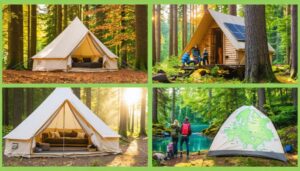
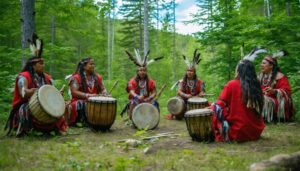

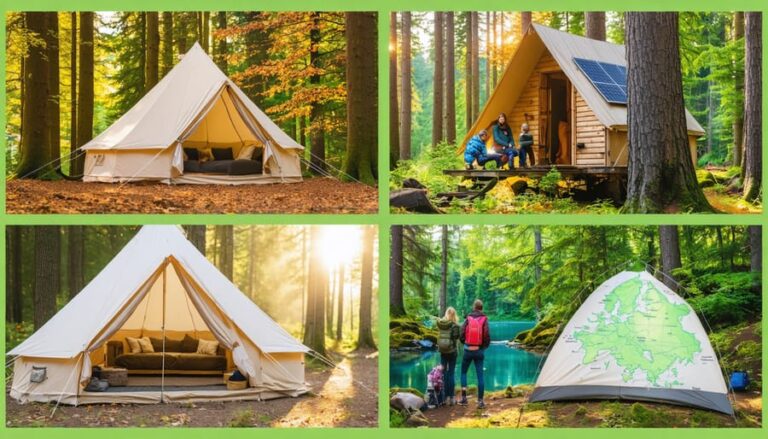
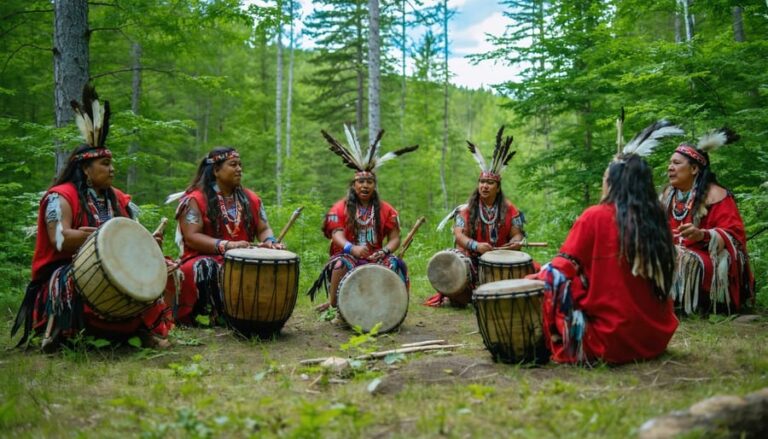



+ There are no comments
Add yours